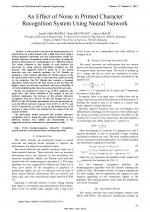| 1/2013 - 11 |
An Effect of Noise in Printed Character Recognition System Using Neural NetworkGHEORGHITA, S. |
| Extra paper information in |
| Click to see author's profile in |
| Download PDF |
Author keywords
backpropagation, character recognition, neural networks, noise perturbation, training algorithm
References keywords
neural(16), networks(9), recognition(8), network(5), character(4)
Blue keywords are present in both the references section and the paper title.
About this article
Date of Publication: 2013-02-28
Volume 13, Issue 1, Year 2013, On page(s): 65 - 68
ISSN: 1582-7445, e-ISSN: 1844-7600
Digital Object Identifier: 10.4316/AECE.2013.01011
Web of Science Accession Number: 000315768300011
SCOPUS ID: 84875336154
Abstract
In this article we present the implementation of a neural network model trained with a high noise level using a backpropagation algorithm and the experimental results for printed character recognition, based on the idea of using the primary information by reorganising it in a different format. The values obtained at the outputs of each network are processed by using analysis algorithms designed for this purpose. The suggested model is made up of two neural networks and two analysis modules. In M1 Module we designed a value analysis algorithm for all the outputs of the two neural networks in order to select the best values provided by the networks. The M2 Module also contains a designed algorithm, which assesses the data based on the fact that the highest values are directly correlated with the probability of correctly identifying the characters entered into the networks. Results are obtained for noise of up to 50% applied to the input data. The values obtained at the outputs of the two modules emphasises the increase of the printed character recognition level up to 89.1% for the M1 module and up to 89.8% for the M2 module, the number of errors decreasing vis-a-vis the RNA2 network response from 12.5% to 10.9%, and 10.2%, respectively. In order to set up the hidden layer of 90 neurons, a value of 92% was obtained at the output of the M2 analysis module.The performed model increased the printed character recognition rate by using the same primary information in a different manner. The validity and functionality of the suggested model are confirmed by experimental results. |
| References | | | Cited By |
Web of Science® Times Cited: 2 [View]
View record in Web of Science® [View]
View Related Records® [View]
Updated today
SCOPUS® Times Cited: 4
View record in SCOPUS® [Free preview]
View citations in SCOPUS® [Free preview]
[1] Study on the influence of noise in the printed character recognition system, Gheorghita, Sandel, Munteanu, Radu, Graur, Adrian, 2013 8TH INTERNATIONAL SYMPOSIUM ON ADVANCED TOPICS IN ELECTRICAL ENGINEERING (ATEE), ISBN 978-1-4673-5980-1, 2013.
Digital Object Identifier: 10.1109/ATEE.2013.6563517 [CrossRef]
Disclaimer: All information displayed above was retrieved by using remote connections to respective databases. For the best user experience, we update all data by using background processes, and use caches in order to reduce the load on the servers we retrieve the information from. As we have no control on the availability of the database servers and sometimes the Internet connectivity may be affected, we do not guarantee the information is correct or complete. For the most accurate data, please always consult the database sites directly. Some external links require authentication or an institutional subscription.
Web of Science® is a registered trademark of Clarivate Analytics, Scopus® is a registered trademark of Elsevier B.V., other product names, company names, brand names, trademarks and logos are the property of their respective owners.
Faculty of Electrical Engineering and Computer Science
Stefan cel Mare University of Suceava, Romania
All rights reserved: Advances in Electrical and Computer Engineering is a registered trademark of the Stefan cel Mare University of Suceava. No part of this publication may be reproduced, stored in a retrieval system, photocopied, recorded or archived, without the written permission from the Editor. When authors submit their papers for publication, they agree that the copyright for their article be transferred to the Faculty of Electrical Engineering and Computer Science, Stefan cel Mare University of Suceava, Romania, if and only if the articles are accepted for publication. The copyright covers the exclusive rights to reproduce and distribute the article, including reprints and translations.
Permission for other use: The copyright owner's consent does not extend to copying for general distribution, for promotion, for creating new works, or for resale. Specific written permission must be obtained from the Editor for such copying. Direct linking to files hosted on this website is strictly prohibited.
Disclaimer: Whilst every effort is made by the publishers and editorial board to see that no inaccurate or misleading data, opinions or statements appear in this journal, they wish to make it clear that all information and opinions formulated in the articles, as well as linguistic accuracy, are the sole responsibility of the author.



